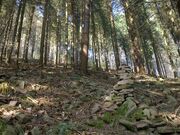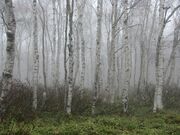
Birds Forests.
Birds Forests (Oceana: Ewtecklessies, IPA: /'ɛʊ̯t̪ɛkˠlɛsʲiə̯s/) is located in the State of Oceana and is one of the largest pine forests of Lovia in terms of geographical area. Most of the soil in the forest is organic-rich kastanozem, but the many rocks and height differences make the area relatively unsuitable for agriculture, especially compared to the areas that lie in the Pacific Plains area. The Birds Forests are a part of the Central Hill Land.
The forests lie east of the Syf Hills and the Done river source, north of the Oceana Wine Region, south of the Lawrence French Massive, and west of That Pitte and the Curland Massive. The only inhabited place that lies in the Birds Forests is Orwnitz. The highest point is the Falconbergh that lies in the northern-most part of the forests.
Species[]
The signature tree of the forest is a variety of Scots pine, Pinus sylvestris var. oceana, better known as the Oceana pine, which is common all over western Peace Island, but rare elsewhere. The tree is the Scots pine tree that occurs on the southernmost longitude. Apart from the Oceana pine that makes up the majority of the trees in the area, there are three species of birch that occur in the forest, in the higher, damper areas, Oceana dwarf birch, or Betula nana var. aviensis occurs. It only occurs in the Birds Forests, the Svolnick Moor, and rarely in the Oceana Emeralds. In the moist, but lower areas of the forests, Betula pubescens or downy birch can be found, although it is a relatively rare tree. Lastly, Betula platyphylla subsp. mandshurica or Japanese white birch is an imported variety that occurs in some former plantations. These were created due to metal shortage in the early days, as the hardness of the wood reduced the effects of wear.
As the forests is very dense, just a little bit of light reaches the soil, which causes it to have only few flowering plants or even shrubs. In the more illuminated spots, ferns and grasses are a common sight. The only plant species that occur all over the forests are mosses. In the birch plantations, the lower vegetation layers have a lot of accidently imported shrubs and plants that were introduced from Japan, together with the birch trees. Due to the isolated location of the plantations and the surrounding dense pine forests, these species are not expanding into other territories, making their eradication very easy.
The Birds Forests lack any large animal species and instead is home to rodents, arthtropods and other bugs, snails and slugs, and, as the name suggests, birds.
Human development[]

A group of Japanese white birches, showing undergrowth, which is almost entirely absent in areas with little to no interference from humans.
Due to its isolated location and, from an agricultural perspective, unattractive soil and lack of mining materials, the Birds Forests remain one of the most untouched natural areas of Lovia. Even in recent times, there has been virtually no interest by farmers, mining companies, or logging businesses to exploit the area. The only economical activities in the area are small-scale lifestock keeping and rarely corn or wheat cultivation, centered around the tiny hamlet of Orwnitz. Other human activities include forestry, although this does not exist in a commercial scale like in some other areas of the state. Instead, forestry in the Birds Forests is focussed on managing and conserving the forest in its current form, and especially keeping paths and unpaved roads free from fallen trees or invasive shrubs, as well as removing undesired, introduced species.
In the past, there have been attempts to use the forests in a more commercial way, but distance and logistics proved to be hindering further development. As a result, there are only a few spots where the pine trees were cut down. These spots are now slowly recovering to their original situation. Another form of forestry that used to be undertaken in the Birds Forests was birch forests, particularly the imported Japanese white birch (Betula platyphylla subsp. mandshurica) was commonly planted. However, the tree is not very adapted to Oceana soil, especially its levels of moistness, and as a consequence it does not thrive well and is slowly going extinct.